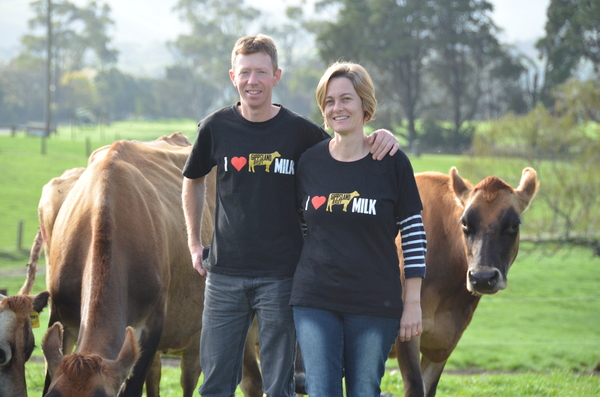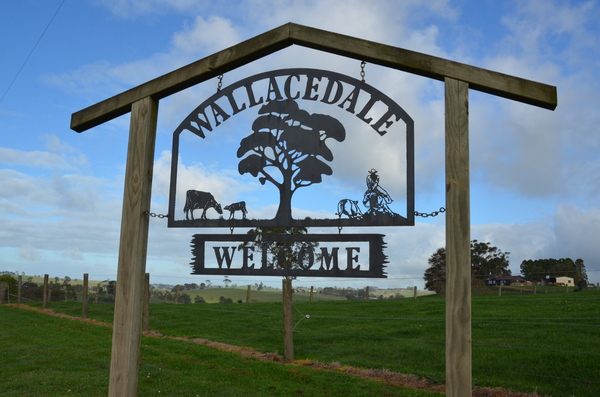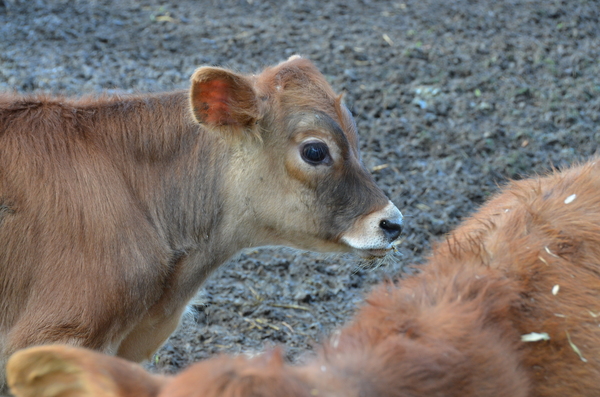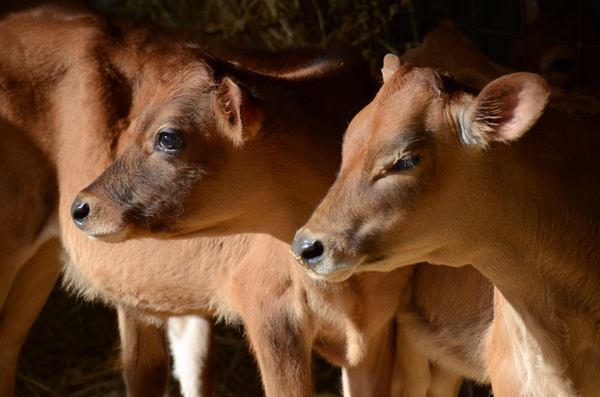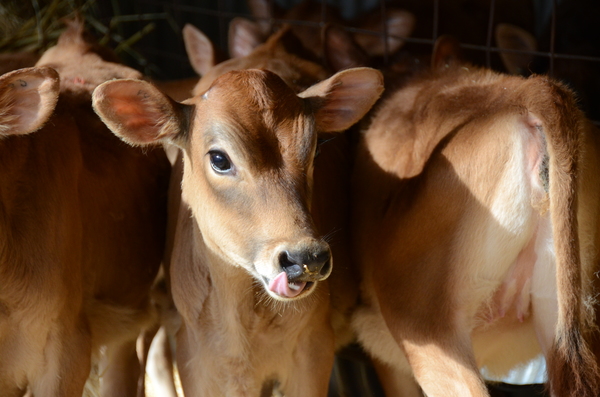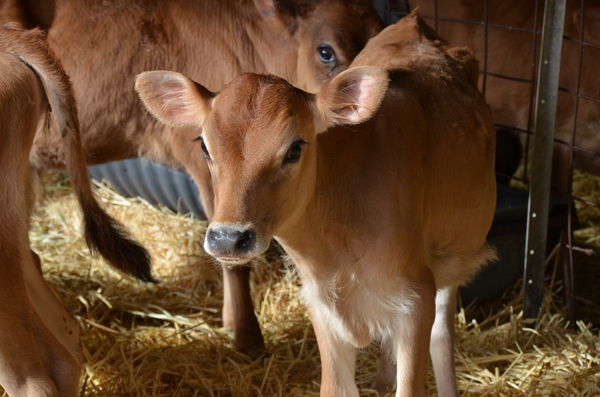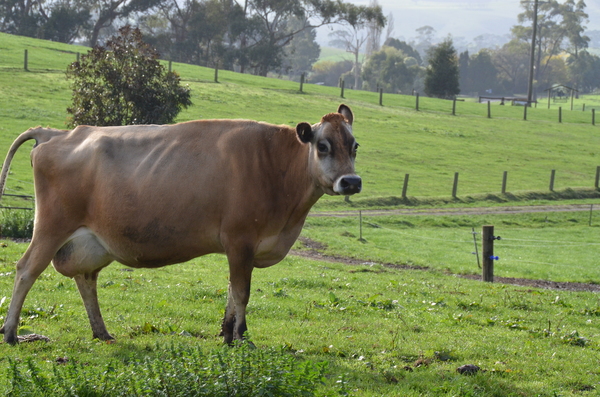
By Casey Neill
Wallacedale Jerseys in Poowong North is the newest addition to the Gippsland Jersey family.
Friends Sallie Jones and Steve Ronalds joined forces to create the milk brand and launched last September.
Steve owns a jersey farm at Jindivick and Sallie moved to Warragul from a dairy farm at Lakes Entrance.
On an Easter holiday in New South Wales, Steve saw farmer-owned milk brand Tilba for sale and in use at cafes.
On his return, he bumped into Sallie at Farm World.
Her dad, a milk processor, had died unexpectedly two weeks earlier and with Tilba in mind, Steve suggested a project to honour him.
“A couple of weeks after Steve and I had that conversation, the milk crisis happened,” Sallie said.
The crisis involved two of the country’s biggest processors – Murray Goulburn and Fonterra – cutting the price they paid farmers for their milk.
“I’ve known Steve for a long time, since we were teenagers,” Luke said.
“His parents and grandparents had jerseys.
“Steve and I did our farm apprenticeship together.”
Mel said: “It was at a time where we were also thinking we need to value add here, we need to find a new way, we would love to process our own milk.”
Luke said that “there’s too many people in the middle, from the time it leaves the farm to the time it gets on the shelves, there’s so many processes and so many hands in the pie”.
“That’s half the reason why we don’t really get reward for the work dairy farmers do,” he said.
The Wallaces threw their support behind Gippsland Jersey.
“It’s been exciting to watch it grow and to have in the back of our thinking ‘if it keeps growing, we could actually become more involved and supply’,” Luke said.
Mel said: “We didn’t think it would only take eight months.”
Luke agreed. But the announcement that Wallacedale would join Steve’s farm as a Gippsland Jersey supplier came on 16 May.
“We thought it would take longer,” he said.
Mel said the dairy crisis had made people more aware of the system and “the fact that farmers are price takers not price makers and they deserve to be supported”.
Luke said: “Everyone throughout the agricultural sector, really, they’re at the mercy of the big companies and the buyers.”
“If you’re not happy with the price that you’re offered, they’ll just go to the next guy until they find someone who’s so desperate.
“We didn’t have the same hit as the Murray Goulburn and Fonterra farmers did.”
He said the situation caused grief, depression and even suicide.
“A lot of people have sold their cows and got off their farm,” Mel said.
The Wallaces still sell most of their milk to Burra Foods, with about 10 to 15 per cent going to Gippsland Jersey.
“That will grow,” Luke said.
“I guess it’s baby steps at the moment.
“At the moment they’re paying for someone else to process the milk because they don’t have their own plant.
“Long term, I think they’d love to be able to process the milk somewhere here in Gippsland so that they can create more jobs for our region, but processing isn’t an easy thing to do.
“There’s lots of rules and regulation around running a factory – not to mention lots of money, time and resources would be required to start something up.
“We want to see Gippsland Jersey just get bigger and bigger.
“We’ve been lucky with the support of IGA stores and cafes and coffee shops.
“We hope to find time to visit some of the existing stockists and thank them and introduce ourselves.
“We can pick up a bottle and say ‘our milk is in this bottle’.
“It’s a very rewarding feeling.
“Steve has a vision and a goal of what he thinks is a fair and reasonable price to pay, which is far above what current factories are paying.
“But to do that, they have to sell the milk at a premium price, too.
“I think it’s a true value of what it’s worth.”
Mel said customer re-education about the true value of milk was key.
“Go and buy yourself a two litre bottle of water and get yourself two litres of milk and which one costs you more?” Luke said.
“What’s involved to get water into a bottle and sell it and what nutritional value is in it?”
He said there was other jersey milk on the market, but it was almost entirely overseas owned.
“More and more of the dairy processors in Australia are part or majority owned by overseas companies,” he said.
Luke’s grandparents bought the Wallacedale property about 60 years ago. He always intended to stay on the farm.
“It’s just what I wanted to do,” he said.
“I have worked off the farm, but still within the industry.
“My grandfather started a jersey stud and then my mother and father carried that on.
“It’s flowed onto us.
“Melanie was born in Swan Hill.
“Her parents were also jersey breeders.”
Mel said: “And so was my grandfather, so we’re both third generation.”
“We met at the Melbourne Show, in the Jersey pavilion.
“My mum and dad introduced us.”
Luke said: “I knew Mel’s parents for a few years before I even knew they had a daughter.”
“I don’t know if they were trying to hide her from me!”
Laughing, Mel said: “I was never ever going to marry a dairy farmer.”
“He must have turned on the charm enough!
“I grew up on a dairy farm, but I never milked cows until I moved here.
“It was not my thing, but it seems to be now.”
Jerseys chose Luke but he wouldn’t have it any other way.
“I actually share-farmed on a holstein farm for two years.
“I got to learn a bit about the differences in the breeds and how much bigger they are.”
He said jerseys were much easier to manage when it came to things like calving.
“During calving season, jerseys have far less problems,” he said.
“Holstein farmers will argue that jersey calves are harder to rear.
“They are smaller so they’re a bit more susceptible if there’s a bug around.”
Luke said jerseys also provided an advantage when it came to feeding.
“The amount of feed and grain that you had to give the big cows versus what we have to give our cows to the amount of milk and kilograms of solids … ” he said.
“Jerseys are much more efficient converters of feed.”
Mel said: “And the paddocks cope a bit better because they’re not as big.”
Luke said the big thing he noticed was handling.
“Somebody my build … for me to drench or to deal with an animal that’s 600kg versus one that’s maybe 420kg, it’s a lot easier,” he said.
“Every litre of jersey milk, when compared to a standard litre of milk in general, there’s far more in it.
“If you take a litre of jersey milk and you want to make cheese or butter or ice cream, you can make more from one litre of that.
“There’s more fat and protein in every litre.
“It’s a higher-energy, high protein food.
“And it tastes better – it doesn’t taste like water.”
The Wallaces milk a maximum of 210 cows.
“We have 194 acres in total. We lease 90 acres off my parents to run all our young cattle,” he said.
“We have another small block where we run bulls.
“We’re about to lease another 115 acres from a neighbour just so we don’t have to rely so heavily on bought-in hay and silage.”
They calve half the herd in autumn and the other half in spring.
“So if we’re not calving we’re joining, if we’re not joining we’re calving,” Mel said.
By joining, she’s referring to artificial insemination (AI).
“The registered side of the business with the genetics, it’s a whole other business,” Luke said.
“It’s a business within the business.
“There’s a lot more time and effort involved, but if you’re prepared to sell your stock – good stock – there’s a return to be made out of well-bred genetics.
“We invest heavily in genetics through using the best AI bulls, doing a lot of embryo transplant work.”
Mel said: “You can potentially get five or six heifers out of one cow in one season.”
Luke added: “But when you do that, you also get bull calves too. You get very well-bred bull calves.
“This year we could sell up to 50 bulls.
“In a poor milk price year, it makes a big difference to keeping your head above water.”
They don’t use a bull for breeding at all.
“The value of a heifer calf is greater from an AI bull than a natural bull,” Luke said.
“They’re in AI for a reason. They’re proven.
“They’ve got information to back up how good or bad they are and what traits they’ll improve.
“You’ll improve your herd much quicker.
“It’s taking a bit of the guess work out of it.”


